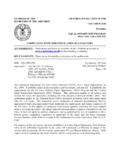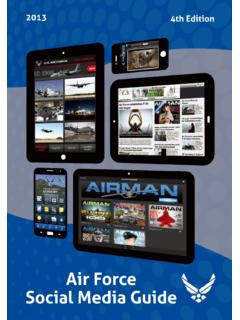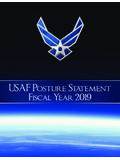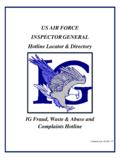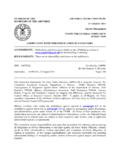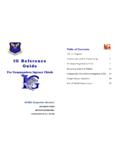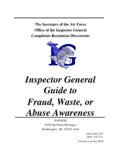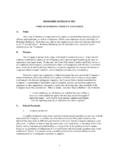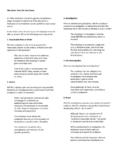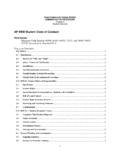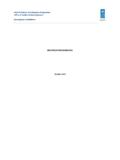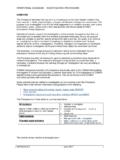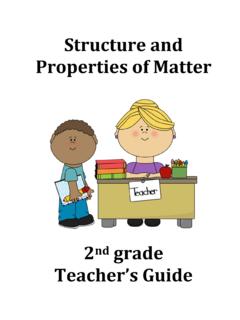Transcription of Commander Directed Investigation (CDI) Guide
1 The Secretary of the Air Force Office of the Inspector General Complaints Resolution Directorate Commander Directed Investigation (CDI) Guide SAF/IGQ 112 Luke Avenue, Suite 150 Joint Base Anacostia-Bolling, DC 20032 (202) 404-6645 DSN 754-6645 Current: as of 18 February 2016 2 TABLE OF CONTENTS PAGE FOREWORD .. 5 CHAPTER 1. INTRODUCTION Guide Overview .. 6 Authority to conduct CDIs .. 6 CDI Purpose .. 6 Standard of Proof .. 6 CHAPTER 2. GENERAL CONSIDERATIONS Matters Appropriate for a CDI .. 6 Standards of conduct .. 6 Abuse of Authority .. 7 2 2. Matters Not Appropriate for a CDI .. 7 Issues Covered by Other Established Grievance or Appeal Channels .. 7 Reprisal and Restriction Allegations .. 7 Senior Official Misconduct .. 8 Self- Investigation .. 8 Sexual Assault .. 8 Domestic Abuse.
2 8 Matters in the Gray Area - Proceed with Caution .. 8 Fraud, Waste, and Abuse (FWA) .. 9 UCMJ Offenses .. 9 Equal Opportunity (EO) .. 9 Completion Timelines .. 9 Reporting Requirements .. 9 CHAPTER 3. CDI TEAM QUALIFICATIONS & RESPONSIBILITIES CDI Team Overview .. 9 Commander (Appointing Authority) .. 9 The Investigating Officer (IO) .. 10 Pre-Investigative Duties .. 10 Investigative Duties .. 11 Post-Investigative 11 The JAG .. 11 The Legal Advisor .. 11 The Legal Sufficiency Review .. 11 Technical Advisor .. 11 Administrative Assistant .. 12 2 CHAPTER 4. INITIATING THE CDI ( Commander S JOB) Frame the Allegations .. 12 Allegation Requirements .. 12 When .. 12 Who .. 12 How .. 12 What .. 12 Allegation Example.
3 13 Appoint the IO .. 13 Arrange the Logistics .. 13 CHAPTER 5. CONDUCTING THE CDI (IO S JOB) Preparation Tips .. 13 Proof Analysis Matrix .. 13 Question Formulation .. 13 13 Organization .. 13 Thoroughness .. 14 14 Evidence Collection .. 14 Testimony .. 14 Witness Availability .. 14 Active Duty Military .. 15 DoD Civilians .. 15 Civilians .. 15 Retirees .. 15 Minors .. 15 Air National Guard; Reserve Personnel .. 15 Order of Witnesses .. 15 Interview Locations .. 16 Local Options .. 16 Remote Witnesses .. 16 Testimony Format .. 16 Under Oath .. 16 Summarized .. 16 Written Statements .. 17 Electronic Recording .. 17 Verbatim .. 17 Telephonic .. 17 Rights 17 Military.
4 17 Civilian .. 18 Third-Party Presence During Interviews .. 18 Labor Union Representatives .. 18 Attorneys .. 19 Other Personal Representatives .. 19 Confidentiality .. 19 3 Immunity .. 19 Air Force Hand-Off Policy .. 19 Physical Evidence .. 20 Objects .. 20 Documents .. 20 Circumstantial Evidence .. 20 Computer Evidence .. 20 Adding New Allegations .. 20 During the Investigation .. 20 Post- Investigation .. 21 How Much Investigation is Enough? .. 21 CHAPTER 6. CDI REPORT WRITING Suggested CDI Investigative File Format .. 21 Appointment and Tasking Letters .. 21 Authority & Scope .. 21 Background & Allegations (Chronology) .. 21 Findings, Analysis and Conclusion .. 21 IFRAC Method .. 22 Issue .. 22 Facts.
5 22 Rules .. 22 Analysis .. 23 Conclusion .. 24 Recommendations .. 24 Testimony .. 24 Evidence .. 24 Technical Reviews .. 24 Legal Review .. 24 Commander (Appointing Authority) Approval and Actions .. 25 Administrative Documents .. 25 Report Markings .. 25 CHAPTER 7. POST-REPORT ACTIONS Closure With Subjects, Suspects, and Complainants .. 25 Use of Results in Adverse Administrative Actions .. 25 CDI Appeals .. 25 CDI Records Release .. 26 Applicability of Privacy Act .. 26 Retention of Records .. 26 Member or Defense Counsel Requests .. 26 Freedom of Information Act (FOIA) Requests .. 26 4 ATTACHMENTS 1. Glossary of References and Supporting Information .. 27 2. References, Referral Agencies and Appropriate Grievance Channels .. 30 3. Administrative/Criminal Investigations Summary.
6 34 4. Abuse of Authority 35 5. IO Appointment Letter .. 36 6. Privacy Act Statement .. 38 7. Sample Investigation Plan .. 39 8. Proof Analysis Matrix .. 43 9. Legal Review .. 45 10. Technical Advisor Appointment Letter .. 47 11. Technical Review .. 48 12. Administrative Assistant Appointment Letter .. 49 13. Witness Invitation Letter .. 50 14. Interview Script .. 51 15. Witness Statement .. 58 16. Summarized Testimony .. 59 17. Report of Investigation (ROI) Sample Format .. 60 18. Report of Investigation .. 61 19. Case Closure Letter .. 67 5 FOREWORD The Secretary of the Air Force, Office of the Inspector General, Complaints Resolution Directorate (SAF/IGQ) administers the Air Force Inspector General (IG) Complaints Resolution Program to resolve problems affecting the Air Force mission. When appropriate, the IG refers complaints to command channels for resolution.
7 The Commander may decide that a particular matter requires objective fact-finding in the form of a Commander Directed Investigation (CDI). At this time, there are no Air Force Instructions (AFIs) prescribing a formal Commander Directed investigative process; therefore, SAF/IGQ and AF/JAA developed this Guide . The Guide provides procedures for commanders and their investigative teams can use to conduct prompt, fair and objective investigations. The procedures contained in this publication are a set of recommended guidelines, and not mandatory. If a user has a recommendation for changes to this Guide , please contact SAF/IGQ at 6 CHAPTER 1. INTRODUCTION Guide Overview. The intent of this Guide is to provide commanders and their investigative team members the tools they need to conduct Commander Directed investigations (CDIs). This Guide should not be cited as authority for conducting a CDI, and its use is not mandatory.
8 IOs should consult with the Commander directing the Investigation as well as the legal office for specific guidance. Authority to conduct CDIs. Commanders appointed in accordance with (IAW) AFI 51-604, Appointment to and Assumption of Command, 11 February 2016, and AFI 38-101, Air Force Organization, 16 March 2011, (on G-series orders) have an inherent authority to conduct a CDI to investigate matters under their command, unless preempted by higher A CDI would normally be initiated by a squadron level or higher Commander . CDI Purpose. The CDI is a tool to gather, analyze and record relevant information about matters of primary interest to those in command. The CDI is an extension of the Commander s authority to investigate and to correct problems within the command. As such, the CDI is internal to the command concerned. There are two reasons a Commander may want to conduct a CDI: to investigate systemic (or procedural) problems or to look into matters regarding individual conduct or responsibility.
9 CDIs are administrative investigations. Standard of Proof. The standard of proof for a CDI is preponderance of the evidence. A preponderance of the evidence is defined as the greater weight and quality of the credible evidence, meaning the evidence indicates that one position is more probable than the opposing position. After weighing all the evidence, the IO may substantiate a finding when the greater weight or quality of the evidence points to a particular conclusion as more credible and probable than the reverse. While, the amount of evidence is something to consider, non-credible evidence will not trump a smaller amount of more credible evidence. Some additional things to consider when weighing the evidence are witness demeanor, opportunity for knowledge, bias, motive, intent, and the ability to recall and relate events. At all times, IOs may use their own common sense, life experiences and knowledge of the ways of the world to assess the credibility of witnesses they interview.
10 CHAPTER 2. GENERAL CONSIDERATIONS Matters Appropriate for a CDI. Generally speaking, commanders may initiate an Investigation into matters within their command when another investigative channel does not exist or is less suitable. For example, investigations into matters that will likely result in a court-martial or other judicial action would normally be referred to the Air Force Office of Special Investigations or Security Forces. Commanders should consult with the SJA regarding whether or not a CDI is the best means of investigating a matter. Command matters include all issues and circumstances involving people, processes and materials under their command. Standards of conduct . CDIs may be used to investigate whether an individual has violated a standard defined by law, regulation, or policy. For example, military members and civilian employees must abide by the Joint Ethics Air Force Instructions govern 1 Higher authority includes specific Air Force directives that delineate organizations responsible to address particular issues or to conduct specific investigations.
